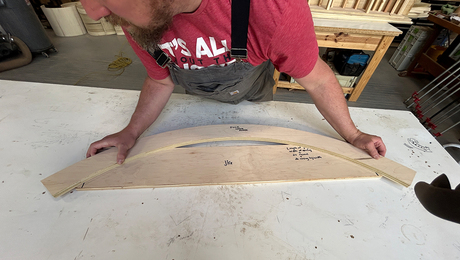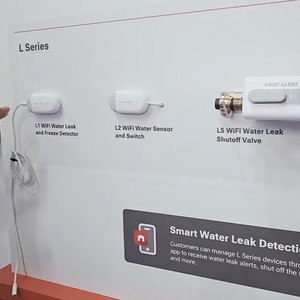Shark bite fittings question

I’m about to use them for the first time and had a question. I was looking at the 3/4″ fittings and some you just push in the 3/4″ pipe and other 3/4″ fittings had a plastic piece in it that went inside the tubing to support the end of the tubing. Like with 1/4″ plastic tubing. You have to strengthen the end with a furrel ? Not sure of the name.
What’s up with that? Is the one with the plastic piece for pex and the other for copper? I don’t want any restrictions inside my tubing.



















Replies
I recently used a couple for the first time, so I'm no expert. Are you talking about the orange plastic horseshoe shaped thing that comes with some fittings? If so, that's the removal tool.
I have a feeling you're talking about something else that I haven't seen.
I found my answer at the manufacturers website. http://www.cashacme.com/_images/pdf_downloads/products/sharkbite/SB_Install_Inst.pdf
The tubing liner is to support the pex where the o-ring compresses around it. One of the main reasons I liked the sharkbite connectors is because they go over the pex. The ones that go inside restrict flow imo.
I know it's a minor thing but flow restriction adds up. Copper fittings go over the tubing so the dia isn't reduced at all.
They do say the it isn't needed for cpvc tubing.
I have used the fittings in question numerous times. There are now at least 2 other manufacturers making a similar product. 1 of them makes a valve for instance that is not able to be reused, so the insertion is permanant. The company that produces the "Sharkbite" fittings in question Is Cash Acme. They have a fairly extensive history of manufacturing pressure reducing valves and the like. They can be used for Pex,Copper, and CPVC, although not PVC. I have held not only water, but also air pressure at some 30 pounds for several weeks with no issues. They are quite the modern miracle, being able to be both rotated once installed AND removed rather easily with that Little orange horseshoe. Unlike other multi material fittings of the past, these ARE rated for both in-wall A N D direct burial......WOW. If you would like to be made aware of the other companies making like products let me know I shall locate that information....
I'm not sure if it exists but I would like a fitting that goes over pex with nothing inside.
If you go to page three they shop how to remove the tube support liner from the fitting. That part goes inside the pex tubing restricting flow.
Here's the link.
http://www.cashacme.com/_images/pdf_downloads/products/sharkbite/SB_Install_Inst.pdf
My other option is to use cpvc but I'd rather not. I want to use 3/4" pex in a hot water circulation loop and run the loops as close to the valves as posible. Since it is flexible I can run the loop up/over close to the point of use and have a short distance from the T to the valve and not use a bunch of fittings. This would give me almost instant hot water, use very few fittings, and have good flow in the loop.
the flow restriction should be quite minimal. the insert isn't that thick and is wider internal diameter than most anything you put in pex... which are almost never problems for a reasonable number of fittings on a line.why so concerned?-------------------------------------
-=Northeast Radiant Technology=-
Radiant Design, Consultation, Parts Supply
http://www.NRTradiant.com
I'm probably being to picky. I like things to be optimal when I can. That's just me. I have looked at them and they are pretty thin.
I'm not an engineer so calculating how much drag a restriction makes would be out of my league. Say you were running a 200' loop of 3/4" pex ( I don't know the inside dia.) and you put 10 T's in the loop. Each T has two of the support sleeves ( i don't know the inside dia) in them. How much drag/restriction/flow reduction would that cause? The loop would be re-circulated by a low flow pump. Would the electricity used by the pump go up significantly?
Maybe it's not even a real factor. And for a one time installation it isn't a big issue.
3/4" is ALOT of capacity for a hot water bypass. All you need is a trickle at least for timed systems, and for sensor systems you would only need something that is the same capacity as the pipe.
Even with the restrictions on the 1/2" fitting causing water to back up to the shower head, it really wasn't that much. I had no trouble withwater flow out the spout. It took me awhile to diagnose the fitting being the problem in that case because the flow was so good.
It's too big if you were planning on running this for your fixtures to, BTW. There is too much water in the pipe over the 1/2" size that you are used to. Bigger pipes hold alot of cold water, and since the flow slower you will still lose a bunch of heat through radiation.Rebuilding my home in Cypress, CA
Also a CRX fanatic!
If your hair looks funny, it's because God likes to scratch his nuts. You nut, you.
I'm not sure I'm following you Paul. If I was supplying a kitchen and two bathroom with hot water across the house would I use 1/2" or 3/4" pipe?
I've been told here that branches that supply bathrooms and kitchen should be 3/4" mainly because if you are in the shower and someone else uses water on that branch you want enough flow that your shower valve isn't starved for water. so you take 3/4" to kitchens and bathrooms and once you get there you can reduce the pipe to 1/2".
Since I want to use less water waiting for the hot water to arrive I am going to put in a re-circulating loop. Since it is a re-circulating loop should it go down to 1/2"?
If I run a loop of 3/4" pipe and insulate it well how much will I lose due to radiation? If you look at a typical water heater with insulation around it and then look at a 3/4" pipe with insulation around it how much better is the water heater insulated?
I have inquired here about pipe insulation that is better than the standard fair you find in supply stores. But None came up. I was thinking about using 3/4" insulation and then putting another layer on top of that. I'm not sure what size that would be.
I have seen insulation that is for air conditioner lines. It is black. Maybe that is a step up.
Well, the best place to keep hot water hot is in your water heater. It's hard to keep water hot in supply lines for any lenth of time, you are actually better off focusing your efforts at reducing the amount of time a gallon of water spends in that line.
Here is where PEX pays off big. Instead of plumbing like copper a "tree" - big branch feeds small branches feeds taps, you plumb it like "grass" - every tap gets it's own small line sized just for its needs. The "soil" in this case is a junction just off your water heater.
In the case of a bathroom, your sink, toilet, and shower all get their own lines. That means 2 hot lines and three cold lines running back to the junction. Now while you are in the shower, your wife can flush and wash her hands without making you shriek like a little girl (Well, that's what happens in my house. I'm man enough to admit I squeal).
Since the hot water is coming directly from the hot water heater DIRECTLY to the tap, it's travel time is reduced. You spend less time waiting for the water to warm up, and you'll probably not need the recirculating pump. BTW, if you still need that pump, just run 1 more PEX to pull the water back.
1/2" is even a little large for direct to taps too. That's why they also make PEX in 3/8" size... no Sharkbites for us in those sizes though :(Rebuilding my home in Cypress, CA
Also a CRX fanatic!
If your hair looks funny, it's because God likes to scratch his nuts. You nut, you.
Paul, I'm not a fan of the home run system. Quick easy solutions are just that in most cases. A well designed water supply system isn't what most people want to do or think about. So the grab onto the latest, greatest thing since sliced bread.
I know how to sweat cooper, fit steel, size (for the most part) waste plumbing.
Having a bunch of pex running through my crawl space to a manifold isn't my idea of a good design/instalation of a water supply system.
I did a seaerch and found this thread just to let you know I'm not alone.
http://forums.taunton.com/tp-breaktime/messages?msg=95892.8
Edited 1/28/2008 1:13 pm ET by popawheelie
really what's best is a hybrid home run.run to a manifold for a bathroom.
run to another manifold for a kitchen.Home run the manifolds back to a main header. One recirc per manifold.This preserves many of the benefits of both methods.Doing copper in plumbing systems is just a waste of time and money though, IMO, except for visible, end connection fittings. More expensive material, harder to install, no real point to it.-------------------------------------
-=Northeast Radiant Technology=-
Radiant Design, Consultation, Parts Supply
http://www.NRTradiant.com
i am pretty sure i saw somewhere that they now have 3/8". it may have been at Home Depot (I work there)
"They can be used for Pex,Copper, and CPVC, although not PVC"
Would that not be because the first three have the same outside dia and equiv nominal pvc does not?
Makes sense to me. I've noiced that some pvc is much thinner than others but the outside dia is the same. If you are going to run cpvc, why not just glue it and use cpvc fittings. The only reason I would use sharbite fittings is in an emergency, joining to different materials/pipes, or running pex.
Edited 1/27/2008 12:03 am ET by popawheelie
It appears that they are fairly well respected. I have not used them. By the way 1/2 pvc is .840 od/.605 id while the cpvc is .625/.485. Did not check copper but od is same as cpvc.
Those numbers seem WAY off.Are you sure that both or 1/2", SCH 40..
.
A-holes. Hey every group has to have one. And I have been elected to be the one. I should make that my tagline.
Also PVC is not approved for interior plumbing so they probably did not bother to test it and get it listed..
.
A-holes. Hey every group has to have one. And I have been elected to be the one. I should make that my tagline.
http://www.evertuff.com/pdf/i-810.pdf (cpvc) see page 8
PART NO. NOM. SIZE UPC # AVG. OD (IN.) MIN. WALL (IN.) PRESSURE WT. PER
611942- AT 23° C OR 73° F 100 FT. (LBS.)
PVC 4005 1/2"x10' 06658 .840 .109 600 PSI 15.9
PVC 4005 1/2"x20' 03922 .840 .109 600 PSI 15.9
PVC 4007 3/4"x10' 06661 1.050 .113 480 PSI 21.1
http://www.charlottepipe.com/Documents/PL_Tech_Man/ABS_PVC_pipe_fittings-TM.pdf (page 23 extract above)
Bob
Edited 1/27/2008 9:53 am ET by rasconc
The Evertough is SDR 11 rated, not SCH rated. I don't know all of the details but SCH rating the wall thickness does not change at the same ratio as the diameter and the pressure rating goes down at the size in creased.SDR the wall thickness is a ration so that the pressure rating is the same regardless of diameter.No I have not messed with an CPVC plumbing, and only limited PVC which was years and years ago. So it might be common that CPVC residential plumbing is SDR and not sch 40.BTW I the only places that I have seen SDR rated pipe is for exterior drains and waste piping. IIRC that SDR 35. But when I researched it apparetly SDR rated is more common in larger size such as would be used for utility work and storm drainage.I looked at the Charlotte pipe PDf and for some reason they don't have any listing for CPVC sch 40, but they do for sch 80.[all of the numbers are for 1/2" nominal]The OD for PVC, sch 40 & sch 80 and CPVC sch 80 are all 0.840 The wall thickness for PVC sch 40 is 0.109The wall thicness for both PVC and CPVC sch 80 is 0.147Here is the listing for sch 40 CPVChttp://www.harvel.com/pipecpvc-sch40-dim.aspIt shows the same 0.840/0.109Now I found this comment. http://www.plumbingworld.com/cpvc_fittings.html#faq"Q-"I get confused about cpvc sizes. You say that yours is 'copper size' but then you say that it is 'schedule 40' which I always thought meant the same size as steel pipe like galvanized. Please help to understand?"A - copper There are two "standard" sizes in CPVC. This makes it all confusing. There is the size that matches the outside diameter of copper. That is what we offer. There also is the CPVC that matches the size of steel pipe. With the CPVC fittings that we sell you simply add 1/8" to the size to determine the outside of the pipe. For example, (for the copper size that we sell) 1/2" CPVC's outside diameter is 5/8" and with 3/4" the outside diameter is 7/8". As far as schedule 40 is concerned, that indicated the thickness and pressure that it can take. Not the size. Schedule 40 CPVC, where it is allowed by code, is acceptable for residential plumbing."See the next message about pipeing types and sizes allowed..
.
A-holes. Hey every group has to have one. And I have been elected to be the one. I should make that my tagline.
While sch 40 cpvc looks like it might be nice I have never seen it used here, always the other (copper size) in my experience. I think that you will find that the atsm is listed in the plumbing code.
I am beginning to agree with all you copper "snobs" (:-) about not using cpvc. I have cut used hot water lines and they tend to shatter and not cut clean like new.
I think pex is going to be the way to go. But then people thought poly-B was the answer. Around here copper tends to pit, however it is not proven that it was not poor quality rather than the ground water.
Agree on interior use but stand fast on diameter being very different, would take a larger part and be difficult to fit both (all three ) types.
I understand that PVC is approved for potable cold water use, but not hot water use.
I'm not a plumber, though.
"I understand that PVC is approved for potable cold water use, but not hot water useI understand that PVC is approved for potable cold water use, but not hot water use"I thought that aslo. Maybe it was at one time, but not now.But I have a copy of the 2000 IRC.It has a table of allowed piping materials.It list has 3 different listings for CPVC - sch 40, SDR, and "Hot and Cold Water Distribution Systesm" each with an ASTM number that defines that product.And also for PVC sch 40, 80, 120 and SDR.Along with 3 kinds of copper, 2 kinds of brass, and many other types of plastic and metal materials.Then it mentions that some plastics can not be used inside dwelling and PVC is is one. Then specifically list plastics that can be used which inlcud CPVC..
.
A-holes. Hey every group has to have one. And I have been elected to be the one. I should make that my tagline.
Thanks for the clarification.
Thanks for the link. I learned something about the Sharkbites.
I just wanted to respond to your concerns about pressure. I recently completed a bathroom remodel. We ran the new water lines to the tub faucet in pex. We used a 1/2 inch pex adapter to a drop ear elbow for the tub spout. Because the water pressure in the area where we were doing the remodel was so high, when you turned the faucet on and had it set so there was a mix of cold and hot water, the 1/2 inch pex fitting restricted the water flow to the point that it pushed up out of the shower head. I had never seen this before. I changed the 1/2 inch pex adapter to a 1/2 inch copper adapter and the problem was solved. My point is that your concern about restricting water flow is valid.